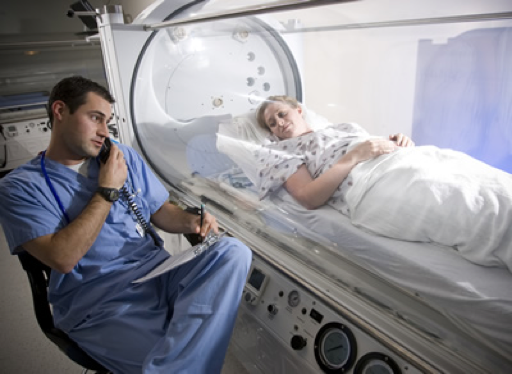
What is Hyperbaric Oxygen Therapy?
Hyperbaric oxygen therapy (HBOT) is a medical treatment which enhances the body’s natural healing process by inhalation of 100% oxygen in a total body chamber, where atmospheric pressure is increased and controlled. It is used for a wide variety of treatments usually as a part of an overall medical care plan.
Under normal circumstances, oxygen is transported throughout the body only by red blood cells. With HBOT, oxygen is dissolved into all of the body’s fluids, the plasma, the central nervous system fluids, the lymph, and the bone and can be carried to areas where circulation is diminished or blocked. In this way, extra oxygen can reach all of the damaged tissues and the body can support its own healing process. The increased oxygen greatly enhances the ability of white blood cells to kill bacteria, reduces swelling and allows new blood vessels to grow more rapidly into the affected areas. It is a simple, non-invasive and painless treatment.
What are the benefits of HBOT?
It has long been known that healing many areas of the body cannot take place without appropriate oxygen levels in the tissue. Most illnesses and injuries occur, and often linger, at the cellular or tissue level. In many cases, such as: circulatory problems; non-healing wounds; and strokes, adequate oxygen cannot reach the damaged area and the body’s natural healing ability is unable to function properly. Hyperbaric oxygen therapy provides this extra oxygen naturally and with minimal side effects.
How does hyperbaric oxygen help brain injury or stroke?
When cells in the brain die, either from trauma or lack of oxygen, blood plasma leaks out into surrounding brain tissue causing swelling and reducing blood flow. These otherwise normal cells go dormant because they can’t function without the appropriate amount of oxygen. HBOT dramatically increases the oxygen carried in the blood plasma, making oxygen available to heal damaged capillary walls, preventing plasma leakage and reducing swelling. As the swelling decreases, blood flow can be restored to the dormant tissue (neovascularization) and these cells then have the potential to function again.
What Conditions Does HBOT Treat?
Clinically Indicated
- Air or Gas Embolism
- Carbon Monoxide Poisoning
- Compartment Syndrome/Crush Injury/Other Traumatic Ischemias
- Decompression Sickness (Bends)
- Diabetic and Selected Wounds
- Exceptional Blood Loss (Anemia)
- Gas Gangrene
- Intracranial Abscess
- Necrotizing Soft Tissue Infection
- Osteoradionecrosis and Radiation Tissue Damage
- Osteomyelitis (Refractory)
- Skin Grafts and (Compromised) Flaps
- Thermal Burns
Off Label
- Autism
- Cerebral Palsy
- Lyme Disease
- Migraine
- Multiple Sclerosis
- Near Drowning
- Recovery from Plastic Surgery
- Sports Injuries
- Stroke
- Traumatic Brain Injury



